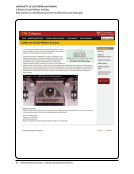SPEC Kit 347: Community-based Collections · 123
UNIVERSITY OF ILLINOIS AT CHICAGO
Bethlehem Howell Neighborhood Center Collection
http://www.uic.edu/depts/lib/specialcoll/services/rjd/findingaids/BHNCf.html
Bethlehem Howell Neighborhood Center collection MSBHNC70 An inventory of the collection at the University of Illinois at Chicago
http://www.uic.edu/depts/lib/specialcoll/services/rjd/findingaids/BHNCf.html[6/23/15, 2:21:06 PM]
University of Illinois at Chicago
Return to Table of Contents »
ADMINISTRATIVE HISTORY
After nearly 50 years of separate settlement house
existence, the Bethlehem Community Center and Howell
Neighborhood House merged in 1965 to form the
Neighborhood Service Organization. The consolidation
occurred after both houses saw their operating budgets
shrink, their once predominantly Czech, Croatian, and
Serbian constituencies move out of the neighborhood, and
the effectiveness of their settlement organizations
dwindle. When both neighborhood houses joined, their
charter stated the new Service Organization's goal as: "To
be a neighbor to the neighbors in such a way that families
are strengthened, lives are made more meaningful and
purposeful and individuals see and understand the dignity
and worth that is theirs as children of God."
In 1884, Congregational Church Union members created
the "Bethlehem Mission" in the predominantly Bohemian
Pilsen neighborhood. Located at 1853 South Loomis
Street, the settlement hosted hundreds of events in its 80
years of existence that included dances, camps, theater
programs, home shows, conferences, church services, and
adult education classes. Bethlehem Center initiated some
of its most far-reaching programs from the 1930s to the
1950s under the direction of H.W. Waltz, Jr. and later,
Clifford Manshardt. In 1944, Manshardt wrote that the
center "[stood] for all that is best in this community." He
continued that out of Bethlehem came "a Man who
challenged the idealism of the world, and it is our hope
that out of this Bethlehem will come men and women who
will challenge all that is mean and degrading in our
community and city." During the 1940s, the Bethlehem
Community Center participated in several war-related
activities and received hundreds of letters from soldiers
serving in the armed forces. After the war, the settlement
house held membership in the Chicago Federation of
Settlements and Neighborhood Centers, the Welfare
Council of Metropolitan Chicago, and the Southwest
Central Community Council. By the 1950s, the increasing
growth of the welfare state combined with the
professionalization of social work and transformed the
settlement movement. Bethlehem and Howell Houses, like
other settlements, became a more structured social
service provider and began working with government
agencies.
The Women's Presbyterial Society established Howell
Neighborhood House for Home Missions, otherwise known
as the "Bohemian Settlement House" in 1905. The
UNIVERSITY OF ILLINOIS AT CHICAGO
Bethlehem Howell Neighborhood Center Collection
http://www.uic.edu/depts/lib/specialcoll/services/rjd/findingaids/BHNCf.html
Bethlehem Howell Neighborhood Center collection MSBHNC70 An inventory of the collection at the University of Illinois at Chicago
http://www.uic.edu/depts/lib/specialcoll/services/rjd/findingaids/BHNCf.html[6/23/15, 2:21:06 PM]
University of Illinois at Chicago
Return to Table of Contents »
ADMINISTRATIVE HISTORY
After nearly 50 years of separate settlement house
existence, the Bethlehem Community Center and Howell
Neighborhood House merged in 1965 to form the
Neighborhood Service Organization. The consolidation
occurred after both houses saw their operating budgets
shrink, their once predominantly Czech, Croatian, and
Serbian constituencies move out of the neighborhood, and
the effectiveness of their settlement organizations
dwindle. When both neighborhood houses joined, their
charter stated the new Service Organization's goal as: "To
be a neighbor to the neighbors in such a way that families
are strengthened, lives are made more meaningful and
purposeful and individuals see and understand the dignity
and worth that is theirs as children of God."
In 1884, Congregational Church Union members created
the "Bethlehem Mission" in the predominantly Bohemian
Pilsen neighborhood. Located at 1853 South Loomis
Street, the settlement hosted hundreds of events in its 80
years of existence that included dances, camps, theater
programs, home shows, conferences, church services, and
adult education classes. Bethlehem Center initiated some
of its most far-reaching programs from the 1930s to the
1950s under the direction of H.W. Waltz, Jr. and later,
Clifford Manshardt. In 1944, Manshardt wrote that the
center "[stood] for all that is best in this community." He
continued that out of Bethlehem came "a Man who
challenged the idealism of the world, and it is our hope
that out of this Bethlehem will come men and women who
will challenge all that is mean and degrading in our
community and city." During the 1940s, the Bethlehem
Community Center participated in several war-related
activities and received hundreds of letters from soldiers
serving in the armed forces. After the war, the settlement
house held membership in the Chicago Federation of
Settlements and Neighborhood Centers, the Welfare
Council of Metropolitan Chicago, and the Southwest
Central Community Council. By the 1950s, the increasing
growth of the welfare state combined with the
professionalization of social work and transformed the
settlement movement. Bethlehem and Howell Houses, like
other settlements, became a more structured social
service provider and began working with government
agencies.
The Women's Presbyterial Society established Howell
Neighborhood House for Home Missions, otherwise known
as the "Bohemian Settlement House" in 1905. The
























































































































































































